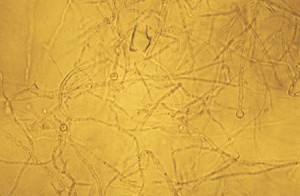
Eduardo CesarTrichoderma fungus: action blockedEduardo Cesar
Apparently, a plant has no way of defending itself when it is attacked by an insect. However, a bite on the leaf sets off the production of a series of substances capable of blocking the action of the insect’s digestive enzymes, which later on may die of indigestion. A defense protein in sugarcane (Saccharum officinalis), identified by researchers from the Federal University of São Carlos (UFSCar), has proved to be effective against fungi that attack sugarcane and other economically valuable plants, so that, with time, it may become a natural product against pests. Canacistatina, as it is called, or canecystatin, has brought a prospect for direct applications in human health for inhibiting the action of cathepsins, proteins that participate in the appearance or the evolution of diseases like osteoporosis, rheumatoid arthritis, and Alzheimer’s disease.
The discovery of canecystatin is a result of the analysis of the function of some 50,000 genes sequenced in the course of the Sugarcane Genome Program, or Sucest (Sugar Cane EST, in a reference to the technique employed, called expressed sequence tags, or EST), concluded at the end of 2000. In São Carlos, geneticist Flávio Henrique da Silva and his doctoring student, Andréa Soares da Costa, who were members of one of the 70 teams sequencing and analyzing the genes, arrived at the protein by comparing genes – from sugarcane and from other plants – that are involved in the defense mechanisms against fungi.
To start with, Flávio Silva and Andréa tested the protein against a species of filamentous fungus, Trichoderma reesei, employed industrially for producing enzymes used in the manufacture of cloth and paper. Trichoderma was picked as it was organism adopted in tests of another molecule of this genus, described two years ago: rice cystatin I, found in rice (Oryza sativa). Since the beginning, the sugarcane protein displayed a structure similar to the rice protein, applied experimentally against the Hypera postica weevil, which attacks alfalfa (Mendicago sativa) – it was an indication that their activities would also be similar. Indeed, the canecystatin worked against Trichoderma .
In October, only one month after the results had been published in Biochemical and Biophysical Research Communications, the team from São Carlos found that the protein also acts against the two most common genera of fungi in sugarcane, Fusarium and Colletotrichum, which are also found in coffee. Other experiments, carried out in conjunction with José Odair Pereira, from the University of Amazonas Foundation, evidenced the same effect against Colletotrichum fungi that also attack the peach palm(Pupunha in the Portguese –Bactris gasipaes), guarana and cashew, plants typical of the northern and northeastern regions.
In research applied to human health, the team from UFSCar and the group led by Adriana Carmona, from the Federal University of São Paulo (Unifesp), demonstrated that canecystatin inhibits the action of lysosomal cathepsins, which, besides their normal physiological role, are involved in the biological processes that originate problems like osteoporosis, cancer, muscular dystrophy or heart diseases. “This discovery may have an enormous application in medicine”, says the researcher. Years of work still lie ahead, but the possibility has come to light of using this molecule in the development of new medicines.
Alternative to transgenics
‘Canacistatina’ was given this name for two reasons: it is specific to sugarcane, and it is a cystatin, a group of molecules that block the action of enzymes called cysteine-proteases. Inhibitors of proteases like canecystatin and rice cystatin are produced more intensely in damaged leaf and root cells, and are involved in the plants’ defense mechanisms against the attack of insects or worms. When swallowed by the Leptinotarsa decemlineata caterpillar, for example, the inhibitors affect the insect’s digestive enzymes and alter its growth. For this reason, Silva believes that the protein of the sugarcane can be used as a natural insecticide – in principle, it would be a more viable and quicker way than developing transgenic plants.
Flávio Silva has still not found the limits to the action of the canecystatin that he discovered with his group. “New applications just keep appearing”, says the researcher, whose laboratory is part of the Structural and Molecular Biology Center (CBME), where the studies to characterize the protein are under way. After mastering the process for purifying the protein, obtained in the laboratory in Escherichia coli bacteria, using the gene of the sugarcane, Silva is working to expand production, and, in conjunction with José Abrahão Neto, from the Faculty of Pharmaceutical Sciences of the University of São Paulo (USP), to develop more stable forms of the protein, which resist variations in temperature.
In one of the joint works with the São Carlos laboratory, a team from the São Paulo State University (Unesp) in São Carlos is going to test canecystatin on the elimination of fungi kept in the bottom of anthills, which serve as food for the worker ants (the queens feed on royal jelly). Silva is not venturing any hunch on the results of this study, which should be ready in the middle of this year, but of one thing he is sure: the discoveries with sugarcane are not limited any more to changing and explaining the life of this plant alone.
The Project
EST (expressed sequence tags) sequencing of Sugarcane; Modality
Regular research benefit line; Coordinator Flávio Henrique da Silva – UFSCar; Investment R$ 598,439.12

